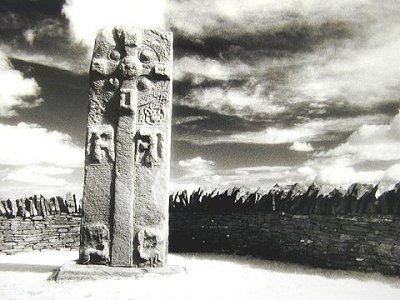Celtic Cross Art Exhibit
Was March 12 - April 27, 2008
Walker's Celtic Jewelry
Fairport NY
In May 2009 Walkers Celtic Jewelry will move to
140 Packets Landing at the corner of South Main Street, Fairport, NY
The ringed cross has been an distinctively Celtic variation of the symbol of Christ�s victory over death since ancient time in Scotland, Ireland, Wales and those parts of the British Isles that were under the influence of the early Celtic Church. From the 5th century onward, ring or wheel-headed crosses were carved in stone as monuments and have been portrayed in paintings, jewelry and sculpture in many forms down to the present time.
Many of the most famous High Crosses survive in the form of large scale stone monuments from 8th to 10th century Ireland. By the 12th century it is believed that the style of the ringed cross had already taken on significance as a reference to something respectably old and dignified. Crosses made in the later medieval period were deliberately archaic for the purpose of connecting their patrons to the distant past and impressing the audience with a sense of well established cultural heritage and lineage to days of saints and heroes.
Because this style of cross along with the style of ornament we call Celtic art has for so long been seen as something very old, the similarity between the ringed cross and pre-Christian wheel and sun symbols has resulted in a folklore that sees the Celtic Cross as having pagan origins. Henry O'Neill, in his 1857 book Illustrations of the Most Interesting of the Sculptured Crosses of Ancient Ireland writes, "I think that ancient Irish art was pagan, and was continued during the Christian period, just as the peculiar form of the Irish cross is pagan, or as the names of the months, or of the days of the week are pagan; these, and a great deal more of paganism, having continued, owing to the tenacity with which a people retain their general habits and ideas."
O'Neill was not himself pagan, as much of his writing contains a Christian piety that would refute such a suggestion. Rather he is expressing pride in a noble antiquity for Irish art. During the 19th century Celtic Revival, much was said and written about native cultural survivals from pre-Christian times. "Pre-Christian" would also be pre-Norman and pre-English domination. It must be remembered that at this time Ireland was reinventing itself. The trauma of famine and foreign rule was fresh. Many ancient Gaelic myths and legends were revived to serve the cause of a renewed sense of national identity and pride in the past.
O�Neill was himself an important player in the nineteenth century Celtic Revival. An exhibition in Dublin in 1853 presented several casts of medieval High Crosses to the Irish public. Prior to this time the ringed cross had fallen out of use and was largely neglected. Fewer than 50 examples survived in Ireland, most of those in damaged condition. The exhibition and O�Neill�s publication several years afterwards were the beginnings of the present rediscovery of this exciting and mysterious symbol of Celtic heritage. By the 20th century the ringed cross had become a popular symbol not only in Ireland, Scotland and the other Celtic nations, but had also been exported to the Celtic Diaspora throughout the world.
The term Celtic Cross is itself considered an obsolete and inexact description of medieval forms of the ringed cross, that is avoided by today�s art historians and archaeologists. It is, however, absolutely appropriate name for modern expressions of the form of the ringed cross for the past 150 years. This exhibit is presented as a celebration of this ancient symbol as it has been portrayed through illustration and sculpture and crafts in modern times.
The question of meaning, especially of the circle, has been a focus of fascination or contemplation for many. Various explanations for the ring attribute "eternity" symbolism to the never-ending circle, or describe it as a form of halo. Some see an evolution from the "Chi Rho" monogram of Christ in a wreath as a prototype. The Egyptian Ankh hieroglyph for "life", which is a circle above a Tau cross, was adopted by early Christians in Alexandria as a symbol of eternal life. The Ankh on a small pedestal meant permanent or enduring life in Egyptian and is very similar to a Celtic cross. Perhaps the most widely repeated story about the cross and circle tells of Saint Patrick preaching to the heathen Irish and drawing a cross through a circle that was inscribed on a Druidic standing stone.
Many High Cross monuments include more parts than just the shaft, cross bar and circle. The capstone and the base are also symbolic components of the entire monument. The capstone is representative of the canopy that was erected over the jeweled cross erected by Saint Helena in the 4th century shrine at Calvary in Jerusalem. In most examples of Irish crosses the capstone is styled as a "house shrine" which was a form of reliquary for a saint�s sacred remains. The base, often stepped, represents Mount Calvary itself, where Christ was crucified.
In medieval times, most of the surviving examples of the ringed cross were public monuments or decorations of communal property such as alter books for the church or liturgical regalia. This was also the case for the earliest crosses of the Celtic Revival, but in more recent decades the trend has been increasingly to use the Celtic Cross as a more personal symbol of devotion, in the form of jewelry or as art for the home.
The Celtic Cross is often seen as an object from the distant past, which it certainly is. This exhibit hopes to demonstrate that the Celtic Cross is also a symbol legitimately inherited through the stewardship of more recent generations and that is being continuously explored and creatively fashioned for the faithful of the present and the future.
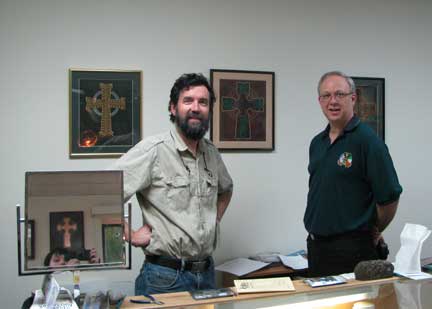
Steve Walker and Ed Rooney with Rooney's artwork
|
11. Bog Oak Celtic Cross Anonymous, Ireland Bog oak is wood that is tens of thousands of years old than has been preserved in peat bogs. This was a popular material for carving Irish themed crafts during the Celtic Revival 1850 - 1930. This small cross was most likely purchased as a souvenir. Private Collection, NFS |
|
12. Silver Pectoral Cross |

Exhibit Catalog with links to artist's webpages
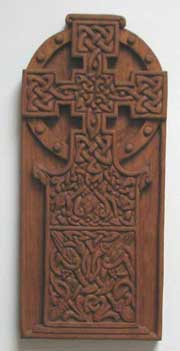 |
1. Slab Cross Hand carved black walnut Alec MacCrea, Alfred, NY 2008, |
|
2. West side of the
West Cross, Monaterboice, Co.
Louth This cross is also known as the Tall Cross. It measures 7 meters high. The figurative scenes illustrate the Crucifixion and the Last Judgment. Local tradition holds that girls who hug the base of the cross are assured that they will find a good man. Lithograph, Henry O'Neill, Ireland 1857 NFS |
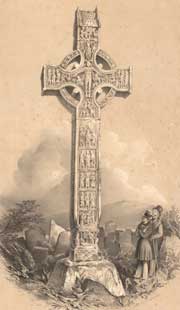 |
Lithograph, Henry O'Neill, Ireland 1857,
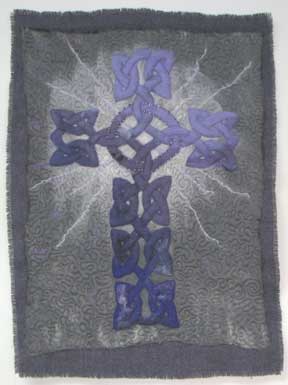 |
4. Felt Cross Wallhanging Hand-made felt with free machine embroidery, hand stitching and beads. The ancient crosses in the North of Scotland are in the form of slabs, rather than free standing. The knotwork consists of one single line in a repeating pattern of triquetra knots - often interpreted as a representation of the concept of The Holy Trinity. Appliqu�, felt on Harris Tweed Ruth Black, Inverness, Scotland 2008, |
Original Painting, Acrylic on acetate film
Jeff Fitzpatrick Adams, Ireland, 1999 $7500
Hand carved American black walnut
William MacCrea, Alfred, NY 1997
Private collection NFS
Lithograph, Henry O'Neill, Ireland 1857, $850
8. Three Celtic Crosses
Giclee print on Val�ron� banner media
Original design in CorelDraw, Open edition
Edward F. Rooney,
Philadelphia, PA, 2006 � 2007,
Glasgow Scotland, Contemporary
A. St. Cuthbert's Cross
B. Celtic Cross
C. Triquetra Cross

10. Models of Pictish Crosses
Plaster, James Gillon-Ferguson,
Dundee, Scotland 2001
Stone sculpture found in Northern Scotland is the
most prominent archaeological remains of the early
Medieval Pictish Culture.
A. Large Aberlemno Churchyard Stone
B. Small Aberlemno Churchyard Stone
C. Inchbroach Stone
Silver in Iona Marble base
Alexander Ritchie, Isle of Iona, Scotland 1930s
Collection of T. Wheeler, Chicago, NFS
Silver in Iona Marble base
Alexander Ritchie, Isle of Iona, Scotland 1930s
Collection of T. Wheeler, Chicago, NFS
White Metal in Iona Marble base
Celtic Art Industries, Scotland 1945-1965
This piece was molded from Alexander Ritchie models.
Private Collection, NFS
Pewter versions of this are still being made by the Art Pewter Co. of east Kilbride Scotland
based on medieval stone sculpture on the Isle of Iona. Alexander Ritchie, Isle of Iona, Scotland 1930s
A. St. John's Cross
B. St. Oran's Cross
C. St. Margaret's Cross
D. Iona Dove. An original design by Alexander Ritchie
E. St. Columba's Pillow
F. MacLean's Cross
G. Interlaced Iona Cross
Swords, Co. Dublin, Ireland, Contemporary
A. Drumcliff Cross
B. Offaly Cross The cross is inspired by the Celtic Revival Crosses from the Ossory area of Ireland. The Diocese of Ossory comprises the county of Kilkenny and parts of the counties Laois and Offaly. The Celtic Revival Crosses from this area are in the main your traditional ringed cross decorated with foliated patterns. Celtic Revival Crosses are normally decorated with the traditional Celtic motifs of interlacing, spirals and zoomorphic designs. The Anglo-Normans had major influence in the Ossory area especially in Kilkenny where there is a considerable corpus of funerary sculpture decorated with foliage and flowers. I like to think that the Ossory Celtic Revival Crosses are a marriage of the native Irish tradition with the Anglo-Norman tradition, which makes the revival crosses from this area unique.
C. Cladagh Cross with gold detail, Sm
D. Cladagh Cross with gold detail,Lg
E. Muiredach's Cross, Sm
F. Muiredach's Cross, Lg
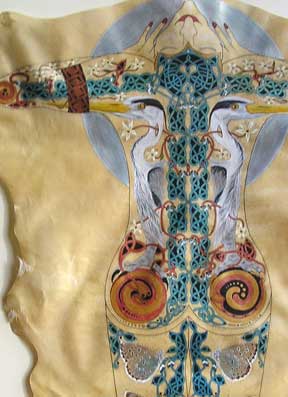 |
18. Lunar Solace Acrylic painting on vellum Burgess and Fiona Hay Kingussie, Scotland, 2008 $6500 |
|
19. Spirit Cross 36 inch high plus base Design by Stephen Walker Pattern carved by Alec MacCrea Cast in Bronze by Glenn Zweygardt Andover and Alfred, NY 2007 Sold |
 |
|
|
|
21. Standing Stone Aberlemno Photograph of an early medieval Pictish monument in Angus, Scotland Catriona Frazier
|
|
22. Gwenhwyfar and Lancelot Original pen and ink drawing Leigh Whetter, Austrailia 1998, |
Embossed paper etching
Patrick Gallagher, Wharton, NJ 1993
B. East Side of the South Cross at Monasterboice (Muirdach's Cross) NFS
Muirdach's Cross is carved with illustrations of biblical stories and is one of the finest "Scripture Crosses" of the ninth and tenth centuries.
C. Tuam Cross and details. The Tuam Cross is an eleventh century revival of the earlier Celtic style, which had fallen out of use for several generations around the beginning of the eleventh century.
Digital print of a stone rubbing
Leslie Reid, Edinburgh, Scotland 2004
The loop on the top of the shaft makes this cross a stylized "Chi Rho" monogram of the name of Christ in Greek Letters. The loop of the Rho is deliberately open to also form a crosier or sheppard�s crook, which is commonly used as a symbol of leadership by bishops and abbots.

Hydrostone renderings of historical sculpture by Ruth and Linda McNay, Texas, Contemporary.
A. St. John's Cross, Iona, Scotland
B. Iona Cross, Scotland
C. Cross of Moone, Co. Kildare, Ireland
D. Muirdach's Cross, Co. Louth, Ireland
E. Iona Cross, Scotland
F. Duleek Cross, Co. Meath, Ireland
G. Slane Abbey Cross (Celtic Revival) Co. Meath, Ireland
H. Quinn Harp Cross (Celtic Revival) Co. Clare, Ireland
Cast resin, Andrew McGarvin, Scotland
A. Iona Cross,
B. Aberlemno Churchyard Cross, Angus
Cast resin, Andrew McGarvin, Scotland
A. Iona Cross,
B. Aberlemno Churchyard Cross, Angus,
handcarved American Black Cherrywood
Alec MacCrea, Alfred, NY 2007

29. Scottish Odyssey Tartan Stole
Machine embroidered tartan and gilded wool appliqu� with tartan
lining and hand-woven fringes. This stole has been designed to be
worn without a chasuble, with embroidery covering the entire
surface. The design is a single continuous line constructed in a
such a way as to create spaces for the gold crosses. There is a
ring around each cross, picked out in a different shade of metallic
thread. At the top of each side, the knotwork changes into a spiral
pattern of three interlinked spirals, representing the Holy Trinity.
The tartan (lining and appliqu�) is Scottish Odyssey and the
stitching is pale gold metallic thread. The gold crosses are gilded
wool. There is a gilt chain across the back neck to allow the stole
to sit neatly across the back.
Ruth Black,
Inverness, Scotland 2008, NFS Commissions are welcome.
Design by Stephen Walker
Pattern carved by Alec MacCrea
Cast in Brass by Glenn Zweygardt
Set in Conemarra Marble base
Andover and Alfred, NY 2008,
Andover, NY, Contemporary, For sale as marked
Married metals and mokume-gane, Sterling and nickel silver, brass, copper, bronze, 14K palladium white gold and 18K yellow gold. This piece illustrates the story of Saint Columba and the heron. The cross is based on the stone carving known as Columba's pillow. Stephen Walker 2004, $12,000
Married metals and mokume-gane, Sterling and nickel silver, brass, copper and bronze. This piece illustrates the traditional Irish legend of the Children of Lir, which can be read as an allegorical history of Ireland. The story begins in Pagan times with four siblings being enchanted into the form of swans. The spell is broken after nine hundred years when they hear the ringing of a church bell, illustrated here as a missionary's hand bell.
Stephen Walker 1997, $12,000
Chris O'Regan, Christchurch, New Zealand 2008,
Machine embroidered Harris Tweed with hand-made felt detail and hand-twisted cord fringe. This panel is inspired by the east face of this well-known free-standing cross on the Isle of Iona. The stone cross itself is 4.3m (just over 14 ft) tall and has a span of 1.19m (47 inches) and has been carved well over 1000 years ago from a single block of grey epidiorite. The west face of the cross has carvings depicting Old Testament scenes. The "snake & boss" ornamentation on the west face is a style found on several free standing Celtic crosses of the area. Much of the fine detail has been lost as a result of weathering which is why I chose to make the bosses by finger weaving wool rovings prior to felting to give the impression of interlace, rather than trying to depict it accurately. Embroidery on Harris Tweed. Ruth Black, Inverness, Scotland, 2008,
Photo of a headstone in Hornell, NY
Richard Burke, Belmont, NY 2006 NFS
39. Dunnamaggin Cross
Lithograph by Henry O'Neill, Ireland 1853 NFS
40. Ringed Cross Wallhanging
Ruth Black,
Inverness, Scotland 2005
Copper reposse, Kathyrn Looby, Canada
James W. Miller 1882, NFS

| 43. The Celebrated Iona Cross, brooch Silver and shells, John M'Gilvray, Oban Scotland 1880s |
 |
44. Scotch Pebble Celtic Cross
necklace Silver, bloodstone, jasper and imitation Cairngorm. 19th century Scotland from collection of Hunter family, Dansville, NY, Jewelry like this, made from native Scottish pebbles, became popular in Scotland during the Victorian era. Family tradition holds that this piece came from Selkirk with an immigrant ancestor in the 1860s. NFS |
Alexander Ritchie was a native of the Hebridean Islands of Mull and Iona.
With his wife, Euphemia Thomson, be began a craft entrprize on the Isle of Iona in 1899 that crafted Celtic designs in many materials, but was most proliffic in silver jewelry.These silver crosses are originals marked with Ritchies hallmark or the mark of the Ritchies apprentice, Iain MacCormick. The Ritchies both died in 1940, but many of their designs are still being made by later generations of craftsmen. "Iona" jewelry is a major influence on today's Celtic jewelry as this medieval design tradition lives on into the future.
Collection of T. Wheeler, Chicago, NFS
